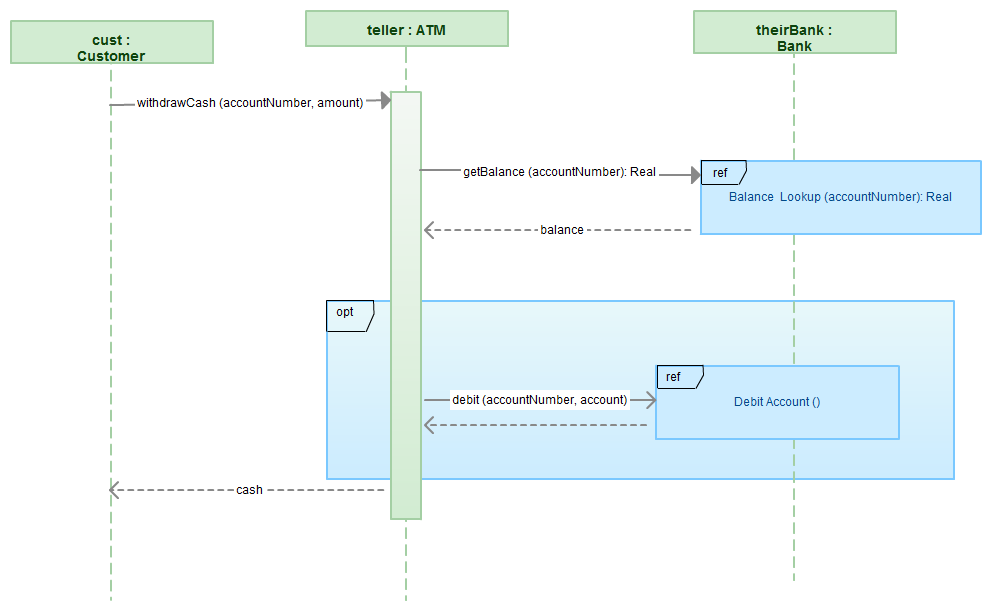

- MAGICDRAW SEQUENCE DIAGRAM ALTERNATE CODE
- MAGICDRAW SEQUENCE DIAGRAM ALTERNATE PASSWORD
- MAGICDRAW SEQUENCE DIAGRAM ALTERNATE PLUS
This is a reply message, so it can be shown with a dashed line. So the login data is correct, and the database sends a message that the user login has been accepted. You can then describe this option, the alternate reality in which the “login data is correct”. Gleek will frame this section with a tidy box. This is where we have to separate part of the diagram with an “alt”, or alternative, operator. Once the database has checked the username and password, the sequence diagram reaches a point where it has two possible paths to take. Because the message is going to and from the same object, Gleek will draw a nice looping arrow.ĭatabase -validate user login data-> Database The database will create and receive a self-message as it validates the user login data. Login page – send user name/password hash->- Database It can sit back and relax while the database does its job! The big thing to remember here is to add a minus symbol to the arrow to remove the activation bar from the “Login page”. The login page sends a message with the user login data to be checked. User – enters username/passsword -> Login page
MAGICDRAW SEQUENCE DIAGRAM ALTERNATE PLUS
Note that you don’t need to use the plus symbol at the end of these arrows, as the “Login page” already has its activation bar. These interactions are all messages to the login page.
MAGICDRAW SEQUENCE DIAGRAM ALTERNATE PASSWORD
Now the user enters their username and password and hits the login button. This will trigger the activation bar for the login page and show that this object is active. Go ahead and accept that and then hit the plus key. Gleek can often predict what you want to type, so it will offer to complete the arrow. To show this interaction, just type a hyphen, then the word “visits”, and then another hyphen. Now the user needs to start interacting with the other objects in the system by visiting the “Login page”.
MAGICDRAW SEQUENCE DIAGRAM ALTERNATE CODE
Just type the word “User” in the code field and Gleek will draw a rectangle with rounded edges to represent an object. Right, let’s put our sequence diagrams to good use and model a login page for a website! First, we need to head over to the Gleek.io app and select “sequence diagram” from the dropdown menu. Step-by-step guide to creating a login system sequence diagram In the sequence diagram, this is represented by an alt, or alternative, operator that creates a frame around part of the sequence showing the choice between accepting or rejecting the user login information. The database responds and the user is either allowed to enter the site or not. This page in turn sends those credentials to the database that stores user information. If not, you will usually get a response telling you to try again.įrom the point of view of the sequence diagram, the user is the first active object and sends credentials to the login page. If everything is correct, you get cleared to enter the site. The server will then run some complicated algorithms to check whether you have submitted the correct password. You enter your data and submit the form, and this is when the sequence diagram kicks in and shows how useful it can be.Īssuming you have filled in both the username/email address and password, the server will first check that the username exists in the system. This is often just your email address and a password. Once the page has loaded, you’re usually presented with a form that allows you to enter your credentials, or in other words the information that you used to sign up for the site. So what actually happens when you arrive on the login page for your favorite website? That’s exactly what a sequence diagram is designed to show. Behind the scenes, any login page involves messages being sent back and forth, objects being activated, and responding with data, and it happens over a discrete period of time. How can you create a sequence diagram for a login system?Ī great example of sequence diagrams is a user login system.


For much more detail, you should check out our sequence diagram page on Gleek. That gives you an overview of what to expect from a sequence diagram. The arrows are usually labeled so that you can easily understand the content of the message. Messages can be sent back and forth, from left to right, and the arrow shows which is the receiver and which the sender of the message. These messages are represented by a line with an arrow. Activity in the system is shown by messages that pass between the objects.


 0 kommentar(er)
0 kommentar(er)
